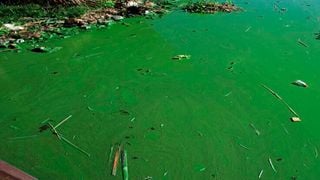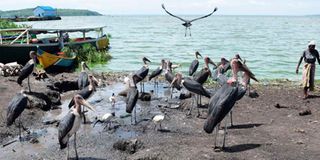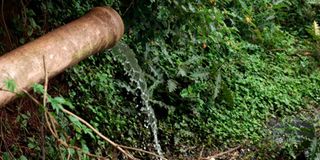Breaking News: Former Lugari MP Cyrus Jirongo dies in a road crash

Algae covers Lake Victoria near Kisat River's mouth in this photo taken on October 20, 2019.
| Jeff Angote | Nation Media GroupCounties
Premium
Mother nature restless as Lake Victoria turned into dumpsite
What you need to know:
- Homa Bay Governor Cyprian Awiti has been quoted saying Lake Victoria is the world's largest septic tank because it is used as a dumpsite.
The look of the surface of Lake Victoria is disturbing. The green mass floating on it also produces a pungent smell.
Ordinarily, the surface would have a deep blue hue, but the colour of the section of the freshwater body in Homa Bay County has changed, indicating that something wrong is happening to the natural resource, robbing it of its beauty and fresh air.
The green strands floating on the lake are algae and other substances that have found their way into the lake.
The surface of the water in Homa Bay town is different from other parts like Suba, where the water is crystal clear and there is always fresh air at the beach.
When you ride on a boat from the beaches off Mfangano Island in Suba, you can see fish swimming in the water.
In Homa Bay town, however, the water surface is oily, dark and does not have fish.
This is despite campaigns by environmentalists and the government for to protect and conserve lake.
Every day of the week, all year round, hundreds of tonnes of foreign substances, solid and liquid, have been introduced into the water through human activities, threatening to destroy the lake’s ecosystem.
'Largest septic tank'
Homa Bay Governor Cyprian Awiti has been quoted saying Lake Victoria is the world's largest septic tank because it is used as a dumpsite.
With a growing population in Homa Bay town and limited infrastructural development like sewer lines and recycling plants, the lake will continue choking from activities that hurt aquatic life.
Residents have illegally redirected sewer systems to discharge effluent into the lake.
Raw sewage is the major pollutant in the lake, said Brian Otiende of the environmental watchdog Nema.
Other substances are farm chemicals and soap from washing clothes and utensils, common activities on the shores of the lake.
“The problem is not only in Homa Bay but in other towns along the lake as well,” he said.
At Shauri Yako, an informal settlement in Homa Bay town, streams of raw sewage drain into the lake at the Koginga beach.
Interestingly, the area is used as the intake point for water supply by the Homa Bay Water and Sanitation Company (Homawasco).
The water is then pumped to treatment plants in Arunda and later distributed to residents.
But environmentalists have raised concerns about the quality of the water supplied to residents.

A section of Koginga beach in Homa Bay Town as pictured on January 14, 2021. Dead fish have been spotted along the shores of Lake Victoria.
Untreated sewage
At the beach, thousands of litres of untreated sewage is deposited in the lake every day and no one seems bothered.
Not even the county government, which is mandated to ensure that the lake is protected from harmful substances.
The lake has been turned into a dumping site for human waste from homes.
The effluent can be traced to residential estates, where the water used in washing clothes and for other domestic activities is then channelled into the lake.
In some areas, clean water from broken pipes flows freely down the road.
The water makes pools from which livestock roaming the streets quench their thirst after grazing in the hot afternoon sun.
In some estates, women and children from low-income families can be seen fetching the water in plastic containers for domestic use.
As the water flows steadily through residential houses, it gets mixed with effluent, which spills from broken pipes and blocked manholes.
All the water forms a major stream flowing through Shauri Yako estate, where the majority of the town’s population lives before being discharged into the lake.
Within the informal settlement, the colour of the flowing water changes and it stinks.
At this point, the stream is also used to dump items like diapers, plastics and other household effluents.
Residents near the broken sewer pipes in Shauri Yako say the foul smell from the stream makes their lives uncomfortable.
Photo gallery: Pollution threatens health of Lake Victoria
Health hazards
Most people in the informal settlement use pit latrines and are exposed to health hazards from the sewer flowing openly.
Maurine Muthama said children in the neighbourhood risk contracting cholera when they drink water contaminated by raw sewage from broken pipes.
"I have an eight-month-old baby that crawls. My worst fear is that one day she may decide to go to the sewer pipe and drink the dirty water,” she said.
Her neighbour, Jane Akoth, said the foul smell from the sewage gives residents stomach upsets.
"It is always hard for me to invite my friends for a visit because I am sure they will not enjoy their stay at my house because of the bad smell from the sewage," she said.
At the onset of the long rains earlier this year, families in the informal settlement found their homes flooded with water contaminated by raw sewage.
Charles Juma, another resident, said his house was filled with rainwater mixed with raw sewage as it flowed into the lake.
"The problem started during the construction of a tarmac road that passes through the residential estate. Workers at the site failed to set up drainage trenches, leading to an uncontrolled flow of rainwater,” he said.
Besides the flow of raw sewage, a disaster is waiting to happen at the Homawasco sewage treatment plant, where the walls separating the lake and effluent sedimentation tanks have collapsed.
In 2019, officials from Nema assessing the level of pollution in the lake discovered that raw sewage would flow from the sedimentation tanks into the lake.
Homawasco repaired the broken wall. But in April this year, the wall collapsed again and raw sewage has been flowing into the lake when it rains and the tanks begin overflowing.

A pipe discharges raw effluent from Maseno University, directly into a river that feeds Lake Victoria, in this picture taken on December 9, 2019.
No reports for Nema
Homa Bay County Nema director Josiah Nyandoro accused the firm of failing to provide the authority with a chemical analysis of the effluent that is being discharged into the lake.
"Results of the analysis should be provided quarterly so that we can advise them on areas to improve on. They are yet to comply with the directives," he said.
Besides the raw sewage, water quality in the lake has also been compromised by engine oil and petrol from vehicles.
At the Koginga beach, several youths have created job opportunities for themselves by washing cars.
Up to 50 cars can be washed at the beach daily and it is a reflection of what is happening on other beaches in Kendu Bay and Mbita town.
Nema has on several occasions warned that it would take action against individuals washing cars in water bodies. But it remains just that - a warning!
Mr Otiende said the lake can be polluted by grease from cars or even substances that the car might have stepped on before going to the lake.
"Oil that is being deposited into the water creates a barrier that prevents oxygen from getting into the water, which affects the breeding of fish. Fish that consume pollutants in the lake may also compromise human health," he said.
But some youths who wash vehicles on the lakeshore defended themselves against accusations of contributing to the pollution, saying they do not open car engines when cleaning them up.
“We only wash the body. No one ever touches the engine because we also know the impact that engine oil has on marine ecosystems,” one of the youths told Nation.Africa.
A few metres from the car wash is the Homa Bay town slaughterhouse, which has also been reported to contribute to pollution in the lake.
In January 2020, Nema issued an order to shut down the abattoir. Workers had dug a trench where blood from slaughtered animals would flow into the lake.
Other animal organs would also be dumped into the water.
But after the closure and warning from the environment agency, the county’s department of agriculture, which manages the abattoir, made some changes to how animal waste is disposed of.
Nema's challenges
Nema officials complained about a shortage of staff, which they said was hampering their work in the region.
“We are only two officers covering the whole county. That is a challenge to us because there are several areas we look into before taking necessary action,” Mr Nyandoro said.
The Homa Bay County government acknowledged that there are lapses in environmental protection.
Water and Environment executive Dickson Nyawinda said the lack of policies to govern environmental protection is the reason for some of the challenges affecting the county.
"We are soon forming policies on environmental protection. In the meantime, I call on everyone to join hands in safeguarding our environment,” he said.
Homa Bay Fisheries Director George Okoth said there are indigenous fish species that might have gone extinct in the lake because of pollution.
"The disappearance of most indigenous fish species is mainly attributed to the introduction of the Nile perch in the lake. But pollution also played a role in their decline and eventual excretion," he said.
In March this year, the founders of the Flipflopi project, which seeks to end plastic pollution in water bodies, sailed across the lake to create awareness on the effects of pollution.
Ali Skanda, a co-founder of the project, said laboratory test results for some of the specimens collected from the lake would be out later this year.
The results will include the quantity and effects of foreign substances in the lake.
Local environmental groups have urged the county assembly to enact laws that can protect the lake.
Aluora Makare, a conservation group, holds that water hyacinth, which has been a thorn in the flesh for fishermen, thrives well in polluted environments.
The group’s leader, Willis Omullo, said a solution to environmental problems in the lake like bathing and washing clothes at the beach should be found.
"We need to reset our connection with nature. Communities and the government should all play their role in environmental protection. The theme of this year’s world environment day is ecosystem restoration. We need to stick to it," he said.





